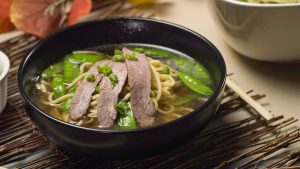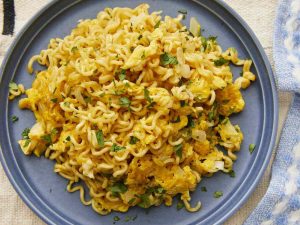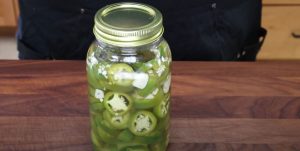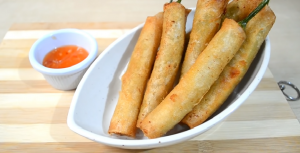Imagine a bowl of warm ramen noodles, seasoned with the delicate flavors of sesame, ginger, and green onions. The simplicity of this dish is its biggest strength, making it a perfect comfort food for any weather. Above all, the sauce adds a rich savory depth, creating an explosion of taste in every bite.
Most of the ingredients of this recipe are commonly found in every household. Ramen noodles can be easily found in the Asian aisle of any supermarket. Fresh ginger and garlic add a kick of spicy flavor. Green onions and sesame seeds bring a nice crunch and freshness. The sauce is a blend of soy sauce, sesame oil, brown sugar, red chili flakes, water, and rice vinegar, adding a perfect balance of sweet, spicy, and tangy flavors.
Necessary Ingredients for Sesame Ramen Noodles Recipe
Ramen noodles: They are thin, wheat-based noodles that become soft and chewy when cooked. They are the main component of this dish.
Ginger: Fresh ginger adds a spicy and slightly sweet flavor.
Garlic: It brings a robust flavor, enhancing the overall taste.
Green onions: They are used for both cooking and garnishing, adding a nice crunch and freshness.
Vegetable oil: It's used for sautéing the ingredients.
Sesame seeds: They add a nutty taste and a delicate crunch to the dish.
Soy sauce: It adds a rich umami flavor.
Sesame oil: It boasts a strong, nutty flavor that complements the other ingredients.
Brown sugar: It adds a touch of sweetness to balance the savory and spicy flavors.
Red chili flakes: They add a spicy kick to the dish.
Water: It's used to dilute the sauce, making sure it's not too overpowering.
Rice vinegar: It adds a tangy taste, balancing out the other flavors.
One reader, Corenda Knowles says:





This sesame ramen noodles recipe is a game-changer! The flavors are so rich and the texture is perfect. The sauce is a delightful blend of sweet and savory, and the sesame seeds add a nice crunch. It's a quick and easy dish that's now a regular in my meal rotation.
Key Techniques for Crafting Sesame Ramen Noodles
How to boil ramen noodles: Boil the ramen noodles for 3 minutes, or just until tender. Drain well, making sure not to overcook.
How to make the sauce: Whisk together the soy sauce, sesame oil, brown sugar, red chili flakes, water, and rice vinegar in a small bowl. Set aside for later use.
How to sauté ginger, garlic, and green onions: Heat the vegetable oil over medium-high heat. Add the fresh ginger, garlic, and whites of the green onions. Cook for 1 to 2 minutes until fragrant.
How to simmer the sauce: Add the remaining sauce ingredients and half of the remaining green onions to the sautéed mixture. Simmer for 1 minute.
How to stir in the noodles: Stir in the cooked ramen noodles and cook for 1 to 2 minutes, or until heated through.
How to garnish with green onions and sesame seeds: Top the finished dish with the remaining green onions and sesame seeds before serving.
How To Make Sesame Ramen Noodles
These sesame ramen noodles made with instant ramen cooked in sesame oil tossed with green onions, and mixed in a tasty ginger sauce will surely be a hit!
Serves:
Ingredients
- 2pkgramen noodles,seasoning packets discarded
- 2tspfresh ginger,grated
- 2clovesgarlic
- 3green onions,finely sliced, whites and greens divided
- 3tbspvegetable oil
- sesame seeds,toasted, for serving
For Sauce:
- 1½tbspsoy sauce,low-sodium
- 1tspsesame oil,toasted
- ½tspbrown sugar,or honey
- ¼tspred chili flakes,or sriracha sauce
- 1tbspwater
- 2tsprice vinegar
Instructions
-
Boil the ramen noodles for 3 minutes, or just until tender. Drain well. Do not overcook.
-
Meanwhile, whisk the sauce ingredients in a small bowl. Set aside.
-
Heat the oil over medium-high heat. Add the ginger, garlic, and whites of the green onions. Cook for 1 to 2 minutes just until fragrant.
-
Add the remaining sauce ingredients and ½ of the remaining green onions. Simmer for 1 minute.
-
Stir in the ramen noodles and cook for 1 to 2 minutes, or until heated through.
-
Top with the remaining green onions and sesame seeds.
Recipe Notes
- Vegetables are great additions to this recipe. Simply stir fry cabbage or other favorite veggies before adding the sauce.
- Leftover protein can also be added to make this a full meal.
- Ramen noodles can be substituted with an equal amount of any other thin noodles.
Nutrition
- Calories: 301.81kcal
- Fat: 19.19g
- Saturated Fat: 4.31g
- Trans Fat: 0.11g
- Monounsaturated Fat: 10.64g
- Polyunsaturated Fat: 3.24g
- Carbohydrates: 27.84g
- Fiber: 1.66g
- Sugar: 1.54g
- Protein: 5.14g
- Sodium: 1120.48mg
- Calcium: 22.62mg
- Potassium: 147.05mg
- Iron: 2.04mg
- Vitamin A: 8.39µg
- Vitamin C: 2.85mg
Mastering the Art of Sesame Ramen Noodles: A Technique Tip
When cooking the ramen noodles, it's important to avoid overcooking them as they can become mushy and lose their texture. To ensure they're cooked just right, keep a close eye on them and taste test a noodle before draining. Remember, they will continue to cook slightly when added to the hot sauce.
Time-Saving Tips for Preparing Sesame Ramen Noodles
Prep ahead: Chop and measure all ingredients before starting the cooking process to save time and streamline the cooking process.
One-pot wonders: Opt for recipes that can be cooked in a single pot or pan to minimize cleanup and save time on washing dishes.
Batch cooking: Prepare larger quantities of the recipe and store the extra portions for quick and convenient meals throughout the week.
Time-saving tools: Utilize kitchen gadgets such as food processors, blenders, and slow cookers to expedite the cooking process.
Make-ahead sauces: Prepare sauces and dressings in advance and store them in the refrigerator for quick and easy flavor enhancement when needed.
Efficient organization: Keep the kitchen organized and maintain a well-stocked pantry to minimize the time spent searching for ingredients.
Substitute Ingredients For Sesame Ramen Noodles Recipe
ramen noodles - Substitute with soba noodles: Soba noodles are a great alternative to ramen noodles, offering a nutty flavor and a firmer texture. They are also a healthier option as they are made from buckwheat flour.
fresh ginger - Substitute with ground ginger: Ground ginger can be used as a substitute for fresh ginger in this recipe. Use 1/2 teaspoon of ground ginger for every 1 tablespoon of fresh ginger called for in the recipe.
garlic - Substitute with garlic powder: Garlic powder can be used as a substitute for fresh garlic. Use 1/8 teaspoon of garlic powder for every clove of garlic called for in the recipe.
vegetable oil - Substitute with sesame oil: Sesame oil can add a rich, nutty flavor to the dish, enhancing the overall taste of the noodles.
soy sauce - Substitute with tamari: Tamari is a gluten-free alternative to soy sauce and has a similar flavor profile, making it a suitable substitute in this recipe.
brown sugar - Substitute with honey: Honey can be used as a natural sweetener in place of brown sugar, adding a touch of sweetness to the dish.
rice vinegar - Substitute with apple cider vinegar: Apple cider vinegar can be used as a substitute for rice vinegar, providing a slightly fruity and tangy flavor to the dish.
Presenting Sesame Ramen Noodles in Style
Elevate the plating: Create a visually stunning presentation by arranging the noodles in a nest-like formation, allowing the sauce to cascade elegantly over the top.
Incorporate texture: Garnish with a sprinkle of toasted sesame seeds to add a delightful crunch and visual appeal to the dish.
Balance the colors: Introduce a pop of color by adding thinly sliced red chili as a vibrant and spicy accent to the dish.
Emphasize freshness: Garnish with thinly sliced green onions to add a burst of freshness and a beautiful green hue to the dish.
Utilize negative space: Embrace the minimalist approach by leaving some areas of the plate bare, allowing the dish to stand out and shine on its own.
Incorporate symmetry: Arrange the components of the dish with precision, creating a visually pleasing and balanced composition on the plate.
Highlight the noodles: Showcase the star of the dish by carefully twirling the noodles into a visually appealing mound at the center of the plate.
Add a touch of elegance: Consider using chopsticks as a sophisticated and traditional utensil for serving, adding an element of finesse to the presentation.
Essential Kitchen Tools for Making Sesame Ramen Noodles
- Saucepan: A saucepan is a deep cooking vessel with a handle and often a lid, used for cooking food on a stovetop. It is commonly used for boiling, simmering, and making sauces.
- Whisk: A whisk is a kitchen utensil used for whipping and mixing ingredients such as eggs, sauces, and batters. It typically consists of a long handle with wire loops at the end.
- Chopping board: A chopping board, also known as a cutting board, is a flat, sturdy surface used for cutting and preparing ingredients. It helps protect countertops and provides a stable surface for chopping and slicing.
- Strainer: A strainer, also known as a sieve, is a kitchen tool used to separate solids from liquids or to strain out unwanted particles from food. It is commonly used for draining pasta or rinsing fruits and vegetables.
- Grater: A grater is a kitchen tool with sharp-edged perforations used for shredding or grating ingredients such as cheese, vegetables, and citrus zest. It is available in various sizes and styles for different grating needs.
- Cooking pot: A cooking pot, also known as a stockpot, is a large, deep vessel with handles and often a lid, used for cooking soups, stews, and boiling pasta or grains. It is an essential tool for preparing larger quantities of food.
- Measuring cups and spoons: Measuring cups and spoons are essential tools for accurately measuring ingredients in cooking and baking. They come in various sizes and are used to measure both liquid and dry ingredients.
- Tongs: Tongs are kitchen utensils with two arms and a pivot at one end, used for gripping and lifting food items. They are commonly used for flipping meat, tossing salads, and serving various dishes.
- Knife: A knife is a versatile kitchen tool used for cutting, slicing, and chopping ingredients. Different types of knives, such as chef's knives, paring knives, and serrated knives, serve various culinary purposes.
- Mixing bowl: A mixing bowl is a deep, round vessel used for combining and mixing ingredients in cooking and baking. It is available in various materials such as stainless steel, glass, and plastic.
- Skillet: A skillet, also known as a frying pan, is a flat-bottomed cooking vessel with sloping sides and a long handle, used for frying, sautéing, and searing ingredients. It is a versatile tool for stovetop cooking.
- Spatula: A spatula is a kitchen tool with a broad, flat blade, used for lifting, flipping, and spreading ingredients. It is commonly used for flipping pancakes, lifting cookies, and scraping bowls.
- Colander: A colander is a bowl-shaped kitchen tool with perforations or small holes, used for draining liquids from food items such as pasta, vegetables, and fruits. It is an essential tool for separating solids from liquids.
- Cutting board: A cutting board, also known as a chopping board, is a durable surface used for cutting, slicing, and preparing ingredients in the kitchen. It helps protect countertops and keeps knives sharp.
- Peeler: A peeler is a kitchen tool used for removing the outer skin or peels from fruits and vegetables. It is available in various designs, including straight, serrated, and swivel peelers, for different peeling needs.
- Saucepan: A saucepan is a deep cooking vessel with a handle and often a lid, used for cooking food on a stovetop. It is commonly used for boiling, simmering, and making sauces.
Storing and Freezing Sesame Ramen Noodles for Later
- Let the sesame ramen noodles cool completely before storing them in an airtight container in the refrigerator. They will keep for up to 3-4 days.
- If you want to freeze the noodles, place them in a freezer-safe container or resealable plastic bag. Squeeze out as much air as possible to prevent freezer burn. The noodles will keep in the freezer for up to 2-3 months.
- When you're ready to eat the frozen noodles, let them thaw in the refrigerator overnight. Reheat them in a skillet over medium heat, stirring occasionally, until they're heated through. You may need to add a splash of water or vegetable broth to loosen up the sauce.
- If you're planning to make the noodles ahead of time for meal prep, it's best to store the noodles and sauce separately. Cook the noodles according to the recipe instructions, then rinse them under cold water to stop the cooking process. Toss them with a bit of sesame oil to prevent sticking, then store them in an airtight container in the refrigerator. When you're ready to eat, simply reheat the noodles in a skillet with the sauce until everything is heated through.
- If you have leftover green onions or sesame seeds, store them separately in airtight containers in the refrigerator. They'll keep for several days and can be used as a garnish for other dishes.
How To Reheat Leftover Sesame Ramen Noodles
Reheat the sesame ramen noodles in a skillet or wok over medium heat. Add a splash of water or broth to help loosen the noodles and prevent them from sticking together. Stir-fry the noodles for 2-3 minutes, or until they are heated through and have regained their original texture.
For a quick and easy reheating method, place the leftover sesame ramen noodles in a microwave-safe bowl. Add a small amount of water or broth to the bowl, then cover it with a damp paper towel. Microwave the noodles on high for 1-2 minutes, stirring halfway through, until they are heated through and have a tender texture.
If you prefer a crispy texture, spread the leftover sesame ramen noodles on a baking sheet lined with parchment paper. Drizzle a small amount of sesame oil over the noodles and toss to coat evenly. Place the baking sheet in a preheated 375°F (190°C) oven and bake for 8-10 minutes, or until the noodles are crispy and heated through.
For a flavorful twist, reheat the sesame ramen noodles in a pot of simmering broth or soup. Add the noodles to the pot and cook for 1-2 minutes, or until they are heated through and have absorbed some of the broth's flavors. This method works particularly well if you have leftover vegetables or proteins that you want to incorporate into the dish.
If you have a steamer basket, you can use it to reheat the sesame ramen noodles. Place the noodles in the steamer basket and set it over a pot of simmering water. Cover the steamer and let the noodles steam for 2-3 minutes, or until they are heated through and have a soft, tender texture. This method helps to retain the noodles' moisture and prevent them from drying out.
Fascinating Facts About Sesame Ramen Noodles
Ramen noodles are a staple in Japanese cuisine and are often enjoyed as a quick and satisfying meal. They can be easily customized with different sauces and toppings to create a variety of flavors and textures.
Budget-Friendly Sesame Ramen Noodles: Is It Possible?
This sesame ramen noodles recipe is quite cost-effective for a household. The ingredients are affordable and easily accessible, making it a budget-friendly option. With ramen noodles, ginger, garlic, and green onions as the main components, the total cost for a household of 4 people would be approximately $10. The flavorful combination of soy sauce, sesame oil, and rice vinegar creates a delicious sauce that elevates the dish. Overall, I would rate this recipe an 8 for its affordability and delightful taste.
Is This Sesame Ramen Noodle Dish Healthy?
This sesame ramen noodles recipe, while tasty, is not particularly healthy. Here's why:
- Ramen noodles are typically high in calories, carbohydrates, and sodium, but low in fiber and protein.
- The recipe uses vegetable oil for cooking, which is high in omega-6 fatty acids and may contribute to inflammation when consumed in excess.
- Soy sauce is high in sodium, and the recipe calls for 1½ tablespoons, which can contribute to high blood pressure and other health issues when consumed regularly.
- The recipe includes brown sugar and rice vinegar, which add extra calories and sugar to the dish.
On the positive side, the recipe incorporates fresh ginger, garlic, and green onions, which offer some nutritional benefits and flavor.
To make this recipe healthier, consider the following suggestions:
- Swap regular ramen noodles for whole wheat or vegetable-based noodles to increase fiber content and reduce refined carbohydrates.
- Use a smaller amount of oil, or opt for healthier cooking oils like olive oil or avocado oil, which are rich in monounsaturated fats and have anti-inflammatory properties.
- Reduce the amount of soy sauce used, or choose a low-sodium variety to decrease the overall sodium content of the dish.
- Add more vegetables to the recipe, such as carrots, bell peppers, or bok choy, to increase the nutrient density and fiber content.
- Include a source of lean protein, like tofu, chicken, or shrimp, to make the meal more balanced and satisfying.
- Limit the amount of brown sugar used, or replace it with a natural sweetener like honey or maple syrup in smaller quantities.
Our Editor's Take on This Sesame Ramen Noodle Recipe
This sesame ramen noodles recipe offers a delightful fusion of flavors and textures. The aromatic blend of fresh ginger and garlic, combined with the savory notes of soy sauce and the subtle heat of red chili flakes, creates a harmonious symphony for the taste buds. The use of sesame oil and seeds adds a nutty richness, elevating the dish to a new level. The simplicity of the preparation belies the complexity of the flavors, making it a perfect choice for a quick and satisfying meal.
Enhance Your Sesame Ramen Noodles Recipe with These Unique Side Dishes:
Delicious Alternatives to Sesame Ramen Noodles
Appetizers and Desserts That Complement Sesame Ramen Noodles
Why trust this Sesame Ramen Noodles Recipe:
This recipe offers a delightful fusion of flavors and textures, creating a satisfying and flavorful dish. The combination of ramen noodles with a savory soy sauce and sesame oil based sauce, infused with aromatic ginger and garlic, promises an authentic and delicious experience. The careful balance of brown sugar and rice vinegar adds a touch of sweetness and tanginess, elevating the overall taste. With the addition of green onions and toasted sesame seeds, this recipe guarantees a delightful umami-rich dish that will surely tantalize the taste buds.
Was this page helpful?
Have your own special recipe to share? Submit Your Recipe Today!










-pilaf-recipe-300x168.png)



